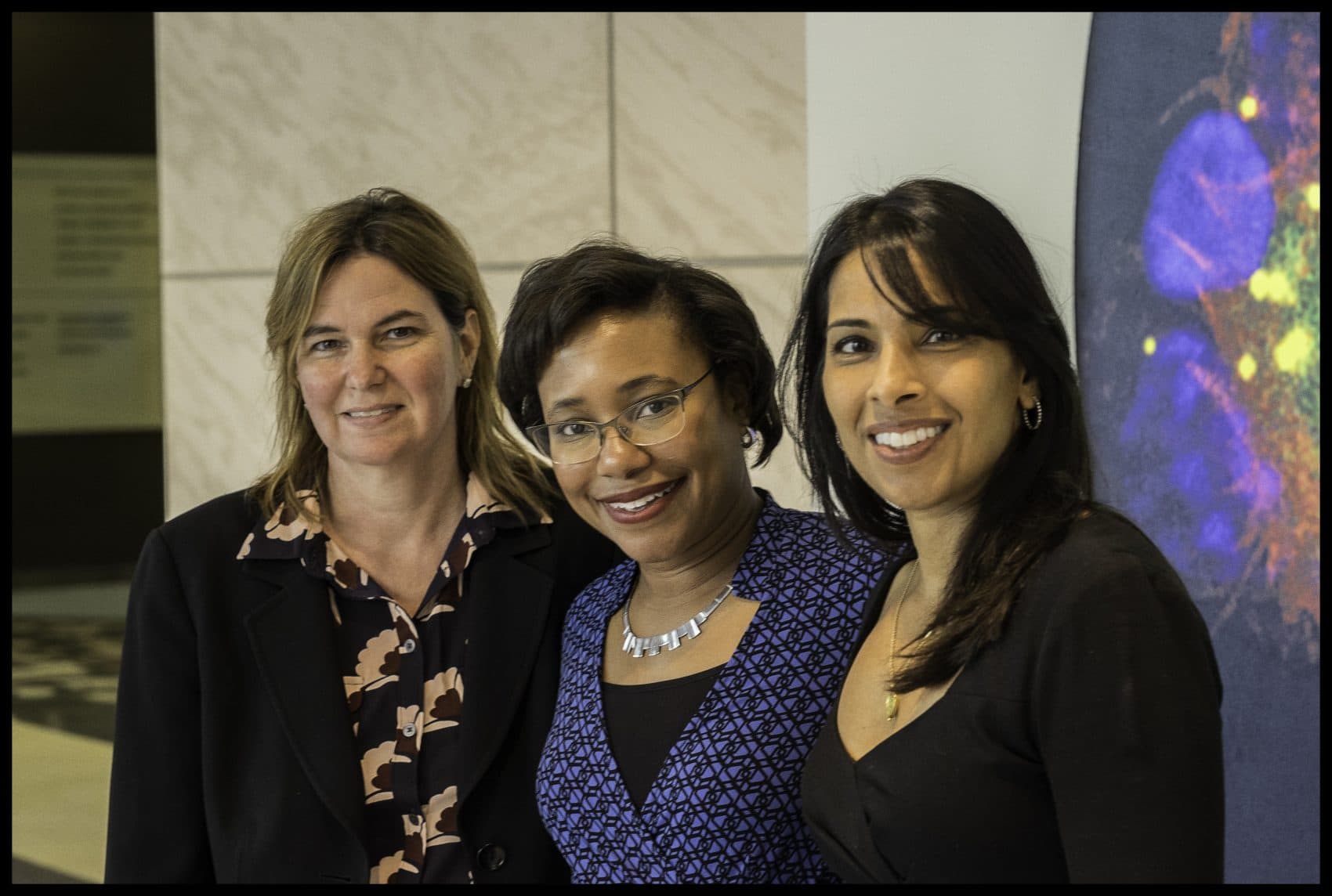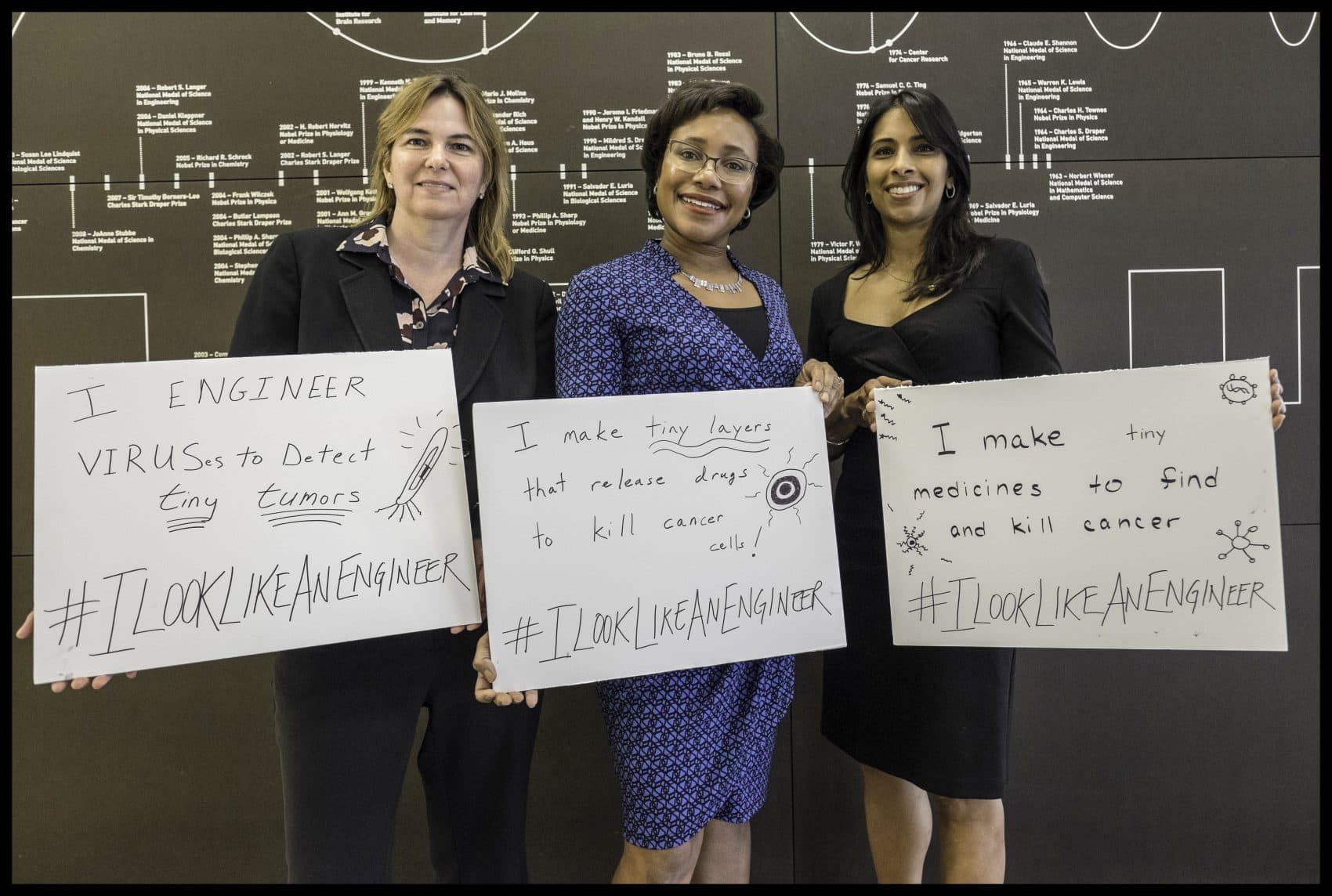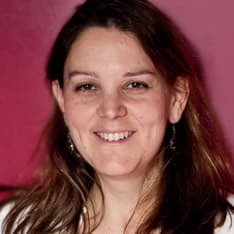Advertisement
Nano-Scale 'Dream Team': 3 MIT Professors Use Tiniest Of Tools Against Cancer
Resume
This story is part of our "This Moment In Cancer" series.
Three MIT professors are innovating at the tiniest possible scale — developing tools to see, target and kill cancer cells before they can cause any harm.
“People have been making things tinier and tinier, mostly to make computers faster,” says Dr. Sangeeta Bhatia, a bioengineer and founding director of MIT’s new Marble Center for Cancer Nanomedicine. “These things that they're making are now 1,000 times smaller than a human hair — so tiny that they can circulate in your body, and we think they can find disease early and hopefully help treat it.”
Bhatia is working on her own nano-medical research, but also collaborates with Paula Hammond and Angela Belcher, fellow members of the Marble and MIT’s Koch Institute for Integrative Cancer Research.
“We feel like this is really a dream team of people that are interested in nanoscience and nanotechnology and focusing those advances on cancer,” Bhatia says.
Collaboration Across Specialties
Although all three professors are bioengineers, they each have their own specialties. Bhatia has a medical degree, Hammond heads MIT’s chemical engineering department, and Belcher's background is in materials science and energy.
Belcher and Hammond first collaborated on developing nanomaterials for solar cells.
“And then we took some of those nanomaterials, which give out really interesting light,” Belcher says, and “we started trying to engineer those to be able to see deeply in the body.”
Belcher says CT scans can find tumors as small as one centimeter across. Using these nanomaterials, she says she can spot tumors as small as a half-millimeter. “If you can start finding tumors that are in the millimeter size, you can catch them much earlier, and if patients are diagnosed in stage 1 or stage 2 of cancer they have a very good survival rate,” she says.
In her own lab, Bhatia is also working on early detection. She has developed a way to use nanoparticles to seek and find early-stage cancer and detect it with a urinalysis similar to a home pregnancy test.
And Hammond's lab is designing nanoparticles built in layers. The outer layer homes in on tumor cells using their “molecular zip codes.” Then there’s an inner layer that can alter the genetics of a cancer cell to override its resistance to chemotherapy. Finally, at the core is a chemo drug that kills the weakened tumor cell without affecting healthy cells around it.
“So the idea is to have this kind of one-two punch,” once the cancer cell has been targeted, Hammond says. “If this is a tumor cell that is resistant to chemotherapy, then you first are releasing something that is going to block that mode of resistance, and then releasing the chemotherapy drug afterward.”
Bhatia, Hammond and Belcher hope to soon blend each of these inventions into a combination diagnostic and therapy – what they call a “theranostic” – against ovarian cancer. They hope to be able to detect tumors at very early stages, and destroy them before they become lethal, while leaving surrounding healthy tissue unharmed.
This kind of collaboration across specialties, in their case chemistry, biology and engineering, is all the rage in science and medicine today — in theory. But Bhatia, Belcher and Hammond say few places have as much as MIT’s Koch Institute, where collaboration is literally built into its Main Street building in Cambridge.
“There are very few physical buildings dedicated to diseases where half of every floor is engineers and half of every floor are biology specialists,” Bhatia says.
Belcher says the mix of specialties has allowed her to be more creative and push her science further. “I'm in a suite of cancer biologists, and that's really, really fun because when I moved in here I didn't know any cancer biology, but it really gives me the ability to accelerate my own growth and learning,” she says.
And Hammond adds that working together means people with different areas of expertise learn how to communicate with one other. “There is actually a biology language, there's language that engineers like to use, and we've learned to understand each other.”
'We’re The Cool Kind Of Nerd'
The three are as passionate about educating students as they are about their research. Students from each of their labs attend joint monthly meetings and are being trained to solve problems, thrive on collaboration, and communicate across disciplines.

Knowing that women are underrepresented at the top levels of science, the three professors say they try to be role models for women, as well as men.
Belcher says in her family it’s worked maybe too well. “My oldest son grew up — he’s 11 now — in this building,” she says. "One time I introduced him to a male colleague of mine and I said, ‘Well, this is my friend; he’s an engineer.’ And then later my son said, ‘Men can be engineers?!’ ”
These three women working together at the highest level of cancer research, also represent another kind of diversity: Bhatia is Indian-American, Belcher is white, and Hammond is African-American.
“We all try really hard to be visible and talk to the public,” Bhatia says, “in part so that they know about the exciting work that we’re doing, but also so that they know all the faces of engineering that are doing this kind of work.”
Belcher says it’s important to get kids interested in science when they’re young.
"We need all the best people [in science]," Belcher says. "We don’t want people in third grade, fourth grade, high school to decide ‘I can’t be a scientist or engineer,’ or ‘I don't want to be.' "
“Or 'I don't want to be a nerd,' ” Bhatia adds.
“I don’t think we’re that nerdy,” Belcher says.
“We’re the cool kind of nerd!” Bhatia insists, laughing.
So far, their science has led to two local startup companies — one for Bhatia's urinalysis diagnostic and one for Hammond's one-two-punch cancer cell killer. They hope to begin testing them in patients within a few years, while still working together on the “theranostic” with support from the Marble Center.
“This is an opportunity to make a change, and the fact that we have these fascinating technologies and that we want to work together is one thing,” Hammond says. “But the fact that we can actually make a difference — that's huge for us.”
